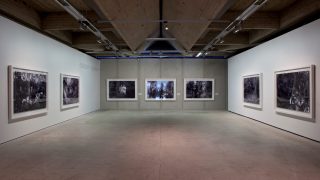Espoo Museum of Modern Art


28.09.2011 - 08.01.2012
Yang Fudong: Utopia And Reality
Yang Fudong is one of China’s leading contemporary artists specialising in the moving image. In autumn 2011 EMMA will show four Fudong video installations – East of Que Village (2007) and three parts of the Seven Intellectuals in Bamboo Forest series (2005-007).
Yang Fudong is considered one of the most talented representatives of Chinese video and film art. He is a brilliant interpreter whose camera work has a magic beautiful, specifically reflecting Chinese aesthetics which are, nevertheless, linked to western modernism. Fudong is known for his timeless and dreamlike interpretations studying human relationships and the stories behind these. Many of his works focus on the problems of the modern generation and the awareness of these brought about by China’s developing society and materialism.
Seven Intellectuals in Bamboo Forest ( parts 3, 4, 5)
Seven Intellectuals in Bamboo Forest is based on an old Chinese story of seven famous Tao artists and poets from the Wei and Jin dynasties. In Fudong’s work people are shown aware of the burden of traditions, values and the past.
The different parts of the work follow the life of seven 20-year-old modern Chinese intellectuals. The location of the first part is China’s Yellow Mountain which has played and important role in the history of Chinese painting. Fudong is interested in the formation of identity and shows this through myths, personal memories and experiences. In the second part of the work the group discusses love and sexuality. Parts 3-5, which will be shown at EMMA, leave the city and move to the countryside and the reality of manual labour. The group works during the day and rests in the evening (part 3). The journey continues to a small island (part 4). The group loves the sea and wants to live on the island, undisturbed and isolated. However, such a life is, perhaps, Utopia. With its new experiences, the group returns to the city and reality (part 5). It continues to be part of a youth collective but a collective which looks to the future and the unknown.
East of Que Village focuses on the feelings of isolation and loss experienced in today’s China in different parts of the countryside: communities are crumbling, rural villages are merging into surrounding urban developments and the struggle for livelihood is gaining the upper hand. Fudong films the Chinese countryside and its everyday struggle for survival amid expanding urbanisation.
The work’s image world is the cold landscape of northern China, a village in the Hebei province, in which a pack of village guard dogs fight to stay alive. The wintery rural village is deserted and forbidding and forms the backdrop to the dogs’ life and death battle. The local inhabitants go about their daily work and their function in the installation is to reflect the struggle between the dogs.
The poetic work is a metaphor of the feelings of isolation and depopulation which the artist sees in contemporary society. The work calls into question the value of work in today’s China and brings to the fore the hopes people have for their own lives. East of Que Village is perhaps the most personal of Fudong’s works and draws on memories of his own childhood with its problems and emotions.
An inspirational, film-like narrative quality is fundamental to Yang Fudong’s art and his work has been compared to the films of Ingmar Bergman and Andrei Tarkovski.